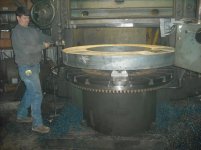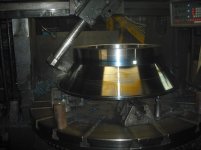Thanks for the advice everyone! Yeah I'm in over my head, and there has been a lot to learn. I was hired because I have some cnc programming experience - but for milling circuit boards. I have been talking to the machine operators about pretty much everything I've been researching, we have a pretty good relationship since I spent a few weeks working with them, training to be a machine operator. Unfortunately no one seems to have used a vertical lathe, so it's been difficult to get much feedback. Fortunately there is no immediate need for this to be figured out.
You never mentioned the type of ops required to turn the part, not that you should in a public forum. Verticals can be awesome if they are applied to the correct part and the money was spent on proper work holding with automated loading and unloading.
If you are turning an ID bore you do not want to use a machine with the spindle mounted in the base. These parts require a top mounted spindle. This also means you will be needing a custom work holding system. $$$. This is fine if you have lots of identical or at least similar enough parts to allow holding the part with a common chucking system.
All of this takes a lot of thought and planning to get it to work well. Any mistakes will be very costly.
One thing I would suggest is that you might want this to be a turn key project. Price for the machine and functioning work holding from one supplier and only one check to write. Why I say this is that I have seen plenty of persons in your situation and experience level that purchase a new machine and do not have the budget or knowledge to finish the project properly. All they ended up with was a shiny new machine that does not perform as well as the old system. The operators are mad, the owner is mad, and you are stuck trying to make something work that will never function as hoped for and it will be your fault.
Vertical spindle lathes are assume for the proper application with the right work holding and the correct loading/unloading system.
The vertical spindle lathes with the spindle mounted in the machine base work well for turning ODs but doing boring work on them is a challenge in that all you have for chip removal is high pressure coolant. If your part is OD only, then you can get by with a base mounted spindle. These can use a hoist or crane from the top and does allow for relatively inexpensive automated loading and unloading.
For parts that have ID boring, the top mounted spindles work better as gravity does the majority of the chip removal but these machines tend to cost more as the part loading and unloading is usually fully automated. The part holding is also more expensive and specialized.
I would caution you on putting too much importance in floor space savings being this is a double edged sword. The floor space saved is wonderful if the actual machine works better than the horizontal lathe. If it does not you have a loose-loose situation.
Depending on your part configuration, you might be just as well off using a conventional horizontal lathe with some well designed loading and unloading fixturing. This all gets back to the OPs needed to do a part and the part variation. These are all of the things you must figure out.
One final comment about the machine tool dealers and this comes after much experience making capital equipment purchases. The good dealers are usually very knowledgeable about the machines they sell and often have some good insight into how to do things. The thing you need top keep in mind is that their bottom line goal is to get you to buy their machine.
The problem is that the good and bad dealers both have the same ultimate goal, to sell you a machine. The good dealers want you as a customer to flourish and buy more machines from them. The bad dealers don't think that far out. They just want this sale.
The trouble comes in getting the machine to make your part and none of the effort from the dealer to make your application work comes cheap. It is easy to get a low price for a machine delivered to your floor. It is another thing entirely to get the low priced machine to make your part. Often, the moderately higher priced machine with the needed dealer support included in the purchase price package will ultimately be the best buy.
Not trying to pick on dealers as the customer is usually the issue but keep in mind the limits of your experience and knowledge. In these situations, keep the end project cost and goal in mind. There is no cheap or easy way to get there.




